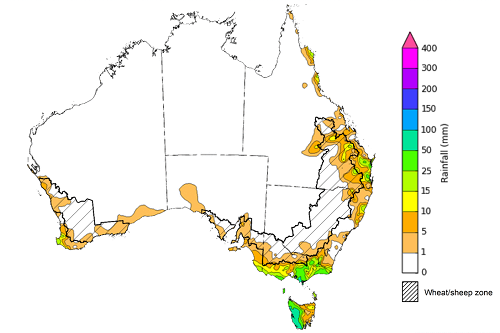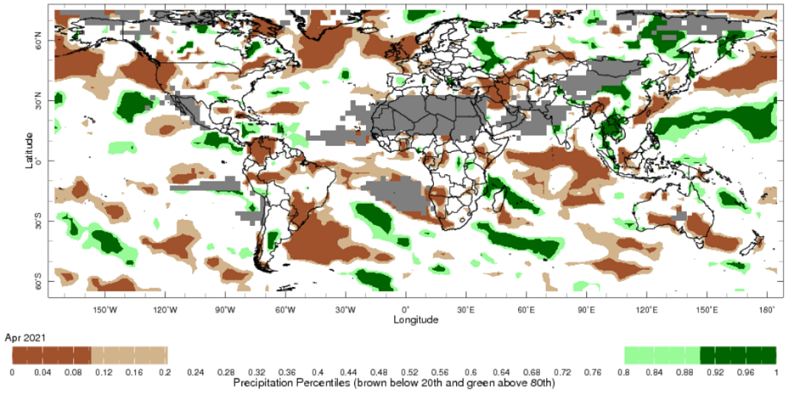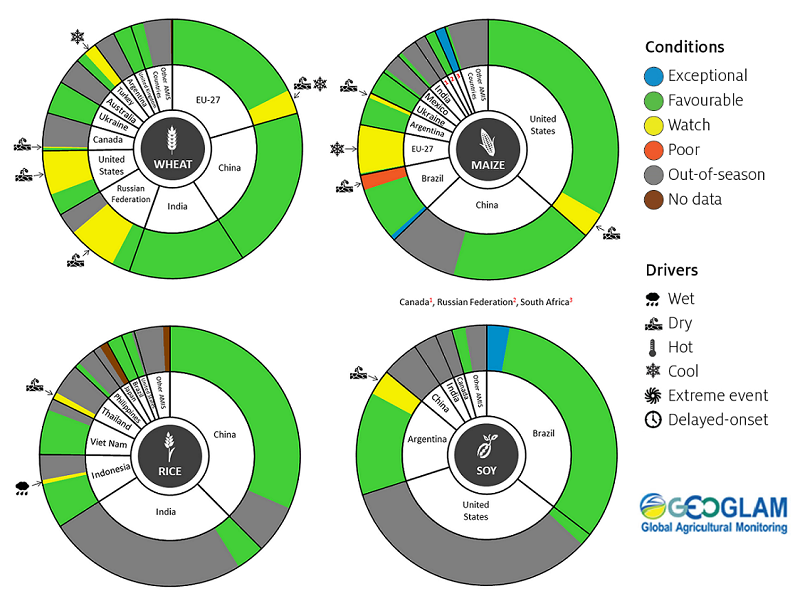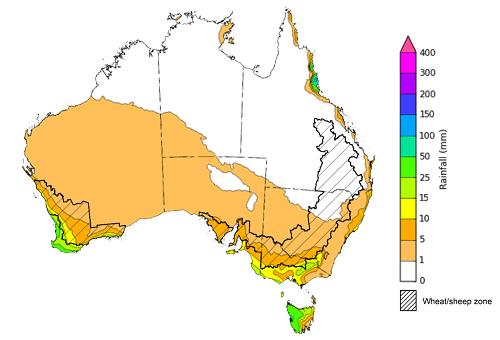Key issues
- During the week ending 19 May 2021, blocking high pressure systems resulted in little rainfall being recorded across much of Australia. However, low pressure troughs and cold fronts generated moderate rainfall across isolated parts of southern and eastern Australia (see Section 1.1).
- The rainfall across cropping regions in Queensland will likely benefit the establishment for early sown winter crops and encourage addition planting activity. Most cropping regions in Victoria and South Australia continued to receive little to no rainfall. Crop sowing has continued in this dry weather. However, rain will be needed soon in these areas to increase topsoil moisture and subsequently trigger more uniform winter crop germination and emergence.
- As at 28 April 2021 global production conditions were generally favourable. A lack of precipitation has affected the production potential of wheat, corn, rice and soy in some key grain exporters and importers.
- April production conditions are similar to those expected back in February, which were used to formulate ABARES forecasts of global grain supplies and world prices in its March 2021 edition of Agricultural commodities.
- Over the next eight days, showers are expected across isolated parts of southern and eastern Australia and high-pressure systems are expected to keep the majority of northern Australia dry.
- In Australia’s cropping regions, rainfall totals of between 5 and 25 millimetres are forecast for parts of south-eastern New South Wales, southern Victoria, South Australia, and western and southern Western Australia. The falls across southern cropping regions may benefit the establishment of early sown winter crops and encourage addition planting activity.
- Water storage in the Murray–Darling Basin (MDB) increased by 205 gigalitres (GL) between 12 May 2021 and 19 May 2021. The current volume of water held in storage is 14,301 GL, which represents 57% of total capacity. This is 48% or 4,613 GL more than at the same time last year.
- Allocation prices in the Victorian Murray below the Barmah Choke increased from $75 per ML on 12 May 2021 to $97 per ML on 14 May 2021. Trade is open from the Murrumbidgee, with prices increasing during the week.
Climate
[expand all]
Rainfall this week
During the week ending 19 May 2021, blocking high pressure systems resulted in little rainfall being recorded across much of Australia. However, low pressure troughs and cold fronts generated moderate rainfall across isolated parts of southern and eastern Australia.
Rainfall totals of between 5 and 50 millimetres were recorded across parts of eastern New South Wales, eastern Queensland, southern Victoria, south-eastern South Australia, south-western Western Australia, and Tasmania. Rainfall totals in excess of 50 millimetres were recorded across isolated parts of southern Victoria and much of western Tasmania.
Little to no rainfall was recorded across most cropping regions during the week ending 19 May 2021. Isolated rainfall of between 5 and 25 millimetres was recorded across parts of northern and eastern Queensland.
In those parts of Queensland that recorded rainfall totals in excess of 10 millimetres, these falls will benefit the establishment for early sown winter crops and encourage addition planting activity. Most cropping regions in Victoria and South Australia continued to receive little to no rainfall. Crop sowing has continued in this dry weather, however rain will be needed soon in these areas to increase topsoil moisture and subsequently trigger more uniform winter crop germination and emergence.
Rainfall for the week ending 19 May 2021
©Commonwealth of Australia 2021, Australian Bureau of Meteorology - Issued: 19/05/2021
Note: The rainfall analyses and associated maps utilise data contained in the Bureau of Meteorology climate database, the Australian Data Archive for Meteorology (ADAM). The analyses are initially produced automatically from real-time data with limited quality control. They are intended to provide a general overview of rainfall across Australia as quickly as possible after the observations are received. For further information go to http://www.bom.gov.au/climate/rainfall/
Global production conditions and climate outlook
As at the end of April 2021, precipitation was average to below average for the world’s major grain and oil producing regions.
In the northern hemisphere, April precipitation was above average in parts of central Canada, central China, south-western Europe, southern India, the west of the Russian Federation, northern Southeast Asia and the south-east of the United States of America.
Precipitation was below average across parts of southern Canada, south-western China, north-western and central Europe, central Indonesia, Kazakhstan, the United Kingdom, and the west and centre of the United States of America. Precipitation was generally average across the remainder of major grain and oil producing regions in the northern hemisphere.
In the southern hemisphere, April precipitation was above average across parts of southern Argentina. Precipitation was below average across parts of south-western Africa, much of southern Australia, and northern and southern Brazil. Precipitation was generally average across the remainder of major grain and oil producing regions in the southern hemisphere.
Global precipitation percentiles, April 2021
Note: The world precipitation percentiles indicate a ranking of precipitation for March, with the driest (0th percentile) being 0 on the scale and the wettest (100th percentile) being 1 on the scale. Percentiles are based on precipitation estimates from the NOAA Climate Prediction Center's Climate Anomaly Monitoring System Outgoing Precipitation Index dataset. Precipitation estimates for March 2021 are compared with rainfall recorded for that period during the 1981 to 2010 base period.
Source: International Research Institute for Climate and Society
As at 28 April 2021 global production conditions were generally favourable. However, a lack of precipitation has affected the production potential of wheat, corn, rice and soy in some key grain exporters and importers.
Conditions for wheat development were generally favourable in Canada, China, the European Union, India, United Kingdom and Ukraine. Variable production conditions in some areas have resulted from previous dry conditions in the Russian Federation, cold weather in Turkey and reduced rainfall in the United States.
Conditions for corn in Argentina were generally favourable as harvest continued, however uneven rainfall during the season has impacted yields. In Brazil, dryness during the season has resulted in poor conditions and reduced yields for spring-planted corn in the south. However, conditions are favourable and exceptional for the spring-planted corn in other regions of Brazil and favourable for of summer-planted corn development. Conditions for harvesting in India and for development in Mexico remained favourable, while conditions in South Africa were exceptional as harvest progressed. Conditions were favourable for sowing in China, the Russian Federation, Ukraine, and the United States of America. Cold and dry weather in the European Union resulted in the issuing of a watch status with a potential risk to average production potential, due to delaying sowing and crop development.
Conditions for rice were favourable as harvesting occurred in Brazil, the Philippines, Vietnam, India, and most of Indonesia. A lack of irrigation water followed by storm moisture damage in Thailand has resulted in a watch status for dry-season rice, pointing to a potential risk to average production potential. Conditions were favourable for sowing in China and the United States.
Conditions for soybeans in Argentina were mixed for early- and late-planted crops undergoing harvest due to a lack of rainfall during the season. In Brazil, conditions have remained favourable as harvesting wrapped up, with exceptional conditions in the north-east. Sowing began under favourable conditions for Ukraine and the southern United States.
Crop conditions, AMIS countries, 28 April 2021
AMIS Agricultural Market Information System.
Source: AMIS
| Region | May-July rainfall outlook | Potential impact on production |
|---|---|---|
| Argentina | Below average rainfall is more likely across most of Argentina between June and August 2021. | Below average rainfall across most of Argentina may adversely affect the planting and development of wheat. In contrast it may allow for uninterrupted harvest of cotton, corn, sorghum, rice, millet and soybeans in June. |
| Black Sea Region | Ukraine - Average rainfall is more likely across most Ukraine. Kazakhstan - Average rainfall is more likely across most of Kazakhstan. The Russian Federation – Average rainfall is more likely across most of Russia and above average rainfall is more likely across parts of eastern Russia. |
Average or better rainfall across the Black Sea Region is likely to support the development of spring wheat in the north and the development of winter wheat, canola, cotton, corn and sunflower in the south. |
| Brazil | Above average rainfall is more likely across parts of northern Brazil and below average rainfall is more likely across parts of southern Brazil between June and August 2021. | Below average rainfall between June and August 2021 across southern Brazil may adversely affect the planting and development of wheat. Conversely, average rainfall across parts of central-west Brazil may benefit corn and cotton prior to harvest in June. |
| Canada | Average rainfall is more likely for much of Canada, with below average rainfall more likely for parts of south-western Canada between June and August 2021. | Average rainfall is likely to support the development of spring wheat and canola, and the planting and development of corn, soybeans and sunflower. Below average rainfall in parts of the south-west may adversely impact the development of these crops. In contrast, below average rainfall may allow for uninterrupted harvest of winter wheat in June. |
| China | Above average rainfall is more likely across parts of northern and south-western China and below average rainfall is more likely across parts of north-western China between June and August 2021. | Average or better rainfall across much of eastern China is likely to support the development of spring wheat, rice, cotton, corn, sorghum, soybeans, sunflower and nuts. This rainfall may also benefit the development of winter wheat and canola prior to harvest in June and July, or it may delay harvesting. |
| Europe | Below average rainfall more likely for parts of south-western and eastern Europe between June and August 2021. | Below average rainfall across parts of Europe may adversely affect the development of winter wheat, canola, corn, cotton, soybeans, sorghum and sunflower. In contrast, close to average rainfall across the remainder of Europe may benefit these crops previously mentioned and average rainfall in northern Europe is likely to benefit the development of spring wheat in Sweden. |
| South Asia (India) | Above average rainfall is more likely across much of India and below average rainfall is more likely across isolated parts of the north-eastern India between June and August 2021. | Above average rainfall across much of India is likely to benefit the planting and development of cotton, corn, sorghum, rice, millet, nuts and sunflower from June 2021. |
| Southeast Asia (SEA) | Above average rainfall is more likely for parts of southern Southeast Asian countries and below average rainfall is more likely for parts of Myanmar and northern Vietnam between June and August 2021. | Average or better rainfall across most of Southeast Asia is likely to benefit corn and rice planting and development. Below average rainfall across parts of Myanmar and northern Vietnam may adversely impact rice and corn production. |
| The United States of America | Above average rainfall is more likely for parts of eastern US and isolated parts of the south-west and below average rainfall is more likely for parts of the north-west between June and August 2021. | Average or better rainfall across much of the eastern and southern US is likely to support the development of winter wheat, spring wheat, canola, cotton and rice, corn, sorghum and nuts and the planting and development of soybeans, sunflower and millet. Below average rainfall in the north-western US may adversely impact the development of these crops and pastures. |
Rainfall forecast for the next eight days
Low-pressure systems are likely to bring isolated showers to parts of southern Australia, while onshore flow is expected to bring falls to parts of the east coast during the 8 days to 27 May 2021. High-pressure systems are expected to keep the majority of northern Australia dry during the next 8 days.
Rainfall totals of between 5 and 50 millimetres are forecast for parts of eastern and southern New South Wales, Victoria, south-eastern South Australia, south-western of Western Australia, Tasmania and parts of north-eastern Queensland. Rainfall totals in excess of 50 millimetres are forecast for isolated parts of north-eastern Queensland and western Tasmania.
In Australia’s cropping regions, rainfall totals of between 5 and 25 millimetres are forecast for the far south of New South Wales, southern Victoria, South Australia and western and southern Western Australia. Little to no rainfall is expected across cropping regions in Queensland and most cropping regions in New South Wales, northern Victoria and eastern Western Australia.
The falls across southern cropping regions may benefit the establishment for early sown winter crops and encourage addition planting activity. The dry forecast for the next 8 days across Queensland and most of New South Wales will maintain near ideal conditions for wheat, barley, and canola planting and early development where soil moisture is adequate to support growth, and continued summer crop harvesting.
Total forecast rainfall (mm) for the period 20 May to 27 May 2021
©Commonwealth of Australia 2021, Australian Bureau of Meteorology - Issued: 20/05/2021
Note: This rainfall forecast is produced from computer models. As the model outputs are not altered by weather forecasters, it is important to check local forecasts and warnings issued by the Bureau of Meteorology.
Water
Water storages, water markets and water allocations - current week
The Tableau dashboard may not meet accessibility requirements. For information about the contents of these dashboards contact ABARES.
Commodities
Information on weekly price changes in agricultural commodities is now available at the Weekly commodity price update.




